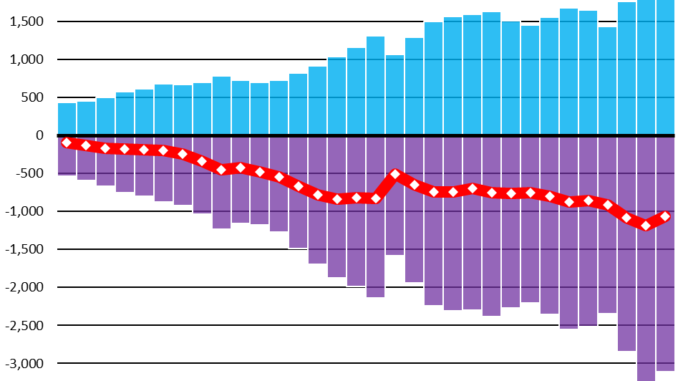
The much improved (or rather less horrible?) trade deficit was one of the reasons GDP was much stronger than expected.
By Wolf Richter for WOLF STREET.
The US trade deficit in goods and services in the year 2023 improved by 19%, or by $178 billion, from 2022, according to the Census Bureau today. “Got less horrible” might be a better term. At $773 billion, the total trade deficit was the least horrible since 2020, due to an improvement in the huge goods trade deficit and a jump to a record in the services trade surplus. More on both in a moment.
The trade deficit (“net exports”) is subtracted from GDP – and the smaller trade deficit amounted to a smaller deduction from GDP. This smaller trade deficit was in part responsible for the surprisingly strong GDP in 2023.
The chart shows just how huge international trade is for the US, with over $3 trillion in exports of goods and services in 2023 (green, added to GDP), and nearly $4 trillion in imports of goods and services (yellow, subtracted from GDP). The red line represents the trade deficit, total exports minus total imports.
The goods trade deficit got less horrible in 2023.
Exports of goods (blue) fell by $39 billion to $2.05 trillion.
Imports of goods (purple) improved by $161 billion to $3.11 trillion.
As a result, the trade deficit in goods (red line) improved by $121 billion, to $1.06 trillion.
The services trade surplus jumped.
Exports of services (blue) jumped by $74 billion, or by 8%, to a record $1.0 trillion.
Imports of services (purple) worsened by $18 billion, or by 3%, to $714 billion.
As a result, the trade surplus in services (red line) jumped by $58 billion, or by 24%, to $288 billion, the third best ever, behind 2019 and 2018.
Spending for international travel is part of the trade in services. Americans traveling overseas and spending money overseas on lodging, restaurants, tickets, etc., counts as imports of services. Foreign tourists, foreign students, foreign business people, etc. spending money in the US on lodging, restaurants, tuition, tickets, etc., counts as exports of services.
Much of international travel came to a halt during the pandemic. By 2022, most of the travel restrictions were lifted or loosened, and travel in both directions rebounded. And 2023 was the year of “revenge travel” for Americans, and their spending overseas was a big factor in the worsening services imports. But foreign tourists, students, etc., also returned to the US in large numbers, and their spending helped push services exports to a record.
We note that the trade surplus in services of $288 billion is dwarfed by the trade deficit in goods of $1.06 trillion.
The US goods trade deficit, by country/region.
The US continues to have the worst goods trade deficit with China plus Hong Kong, which we now treat as one country. Nevertheless, in 2023, the goods trade deficit improved to the “least horrible” level since 2010:
Imports of goods from them: -$110 billion, or -20.3%, to $431 billion, lowest since 2012.
Exports of goods to them: -$4 billion, or -2%, to $176 billion.
Trade deficit in goods: -$105 billion, or -29%, to $256 billion, lowest since 2010.
The 15 trade partners with which the US has the largest goods trade deficits.
The opaque nature of international trade, such as trans-shipments through third countries, trade invoicing via third countries, etc., produces special effects, such as Ireland, which actually doesn’t export much to the US, but in which many huge US companies have entities through which winds the paper trail of their imports into the US. Vietnam has moved way up on the list in recent years as it has become a major transshipment center for China’s exports to the US to dodge US tariffs.



